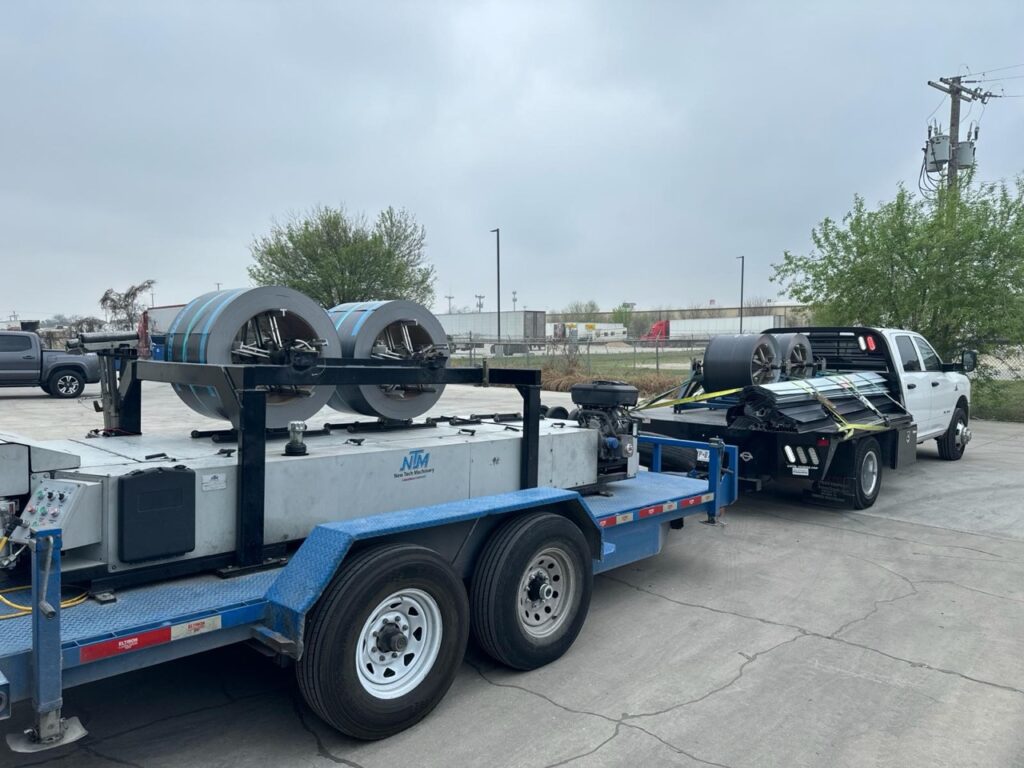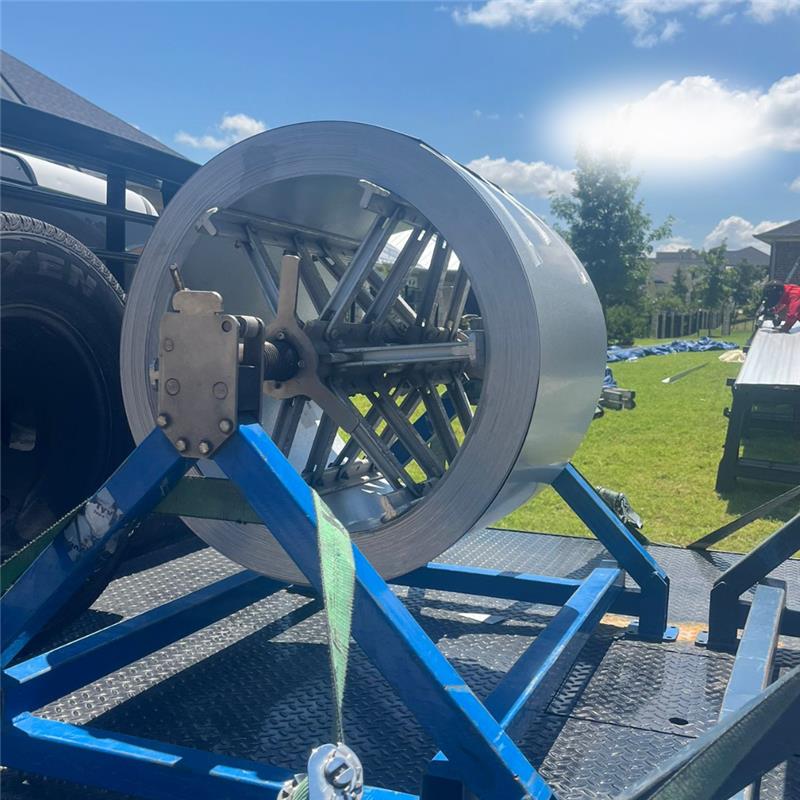When it’s time to replace your roof, the options can seem overwhelming. Among the many choices available to homeowners today, metal roofing stands out for its durability and longevity. But even within the metal roofing category, you’ll face another important decision: should you choose traditional metal panels or rolled metal roofing?
This choice affects not only your initial investment but also your long-term satisfaction and the overall value of your home. In this comprehensive guide, we’ll walk through everything you need to know to make an informed decision between these two popular options, with a special focus on cost considerations that matter to homeowners like you. Whether you’re building a new home in San Antonio or replacing an aging roof, understanding these differences could save you thousands of dollars and countless headaches down the road.
Table of Contents
The Basics: What Are Traditional Metal Panels?
Traditional metal panels have been a staple in the roofing industry for decades. These panels typically come in pre-cut sections that are manufactured to specific dimensions before arriving at your property. Most commonly, these panels are made from:
- Galvanized steel: Steel coated with zinc for corrosion resistance
- Aluminum: Lightweight and naturally resistant to rust
- Copper: A premium option known for its distinctive aging process
- Zinc: Highly durable with self-healing properties for scratches
Traditional panels usually feature a standing seam design, where raised seams connect panels together and keep water from penetrating. These panels generally measure between 12 and 24 inches in width and come in lengths that can be customized to your roof’s dimensions.
The defining characteristic of traditional panels is their rigidity. Once manufactured, they maintain their shape throughout the installation process and the life of your roof. This rigidity offers certain structural advantages but also creates some limitations that we’ll explore throughout this analysis.
Understanding Rolled Metal Roofing Systems
Rolled metal roofing represents an evolution in metal roofing technology. As the name suggests, this material comes in continuous rolls that can be run from the peak of your roof down to the eaves without seams. Let’s break down what makes rolled metal roofing distinctive:
Rolled metal roofing is typically manufactured from the same base materials as traditional panels, including steel, aluminum, and occasionally copper or zinc alloys. The key difference lies in the production method and final form. Instead of being pre-cut into panels at the factory, rolled metal roofing is:
- Produced in long, continuous sheets
- Delivered to your job site in large rolls
- Cut to the exact length needed during installation
- Formed and seamed on-site using specialized equipment
This on-site customization eliminates many of the cross-seams found in traditional panel installations. Think of it like the difference between wallpaper that comes in pre-cut strips versus a continuous roll that you cut precisely to fit your wall height. This seamless approach offers significant advantages in terms of leak prevention and water resistance.
Why it matters: The continuous nature of rolled metal roofing means fewer seams where water can potentially penetrate, especially on long roof runs. For homes with simple rooflines, this can be a major advantage over traditional panels.
Initial Cost Comparison: Sticker Shock vs. Reality
When comparing price tags, traditional metal panels and rolled metal roofing present different cost structures that can initially confuse homeowners.
Traditional panel pricing typically ranges from $8 to $14 per square foot installed, depending on the material quality and profile complexity. These panels generally have:
- Higher material costs per square foot
- Lower specialized labor requirements
- More predictable estimation due to standardized sizing
Rolled metal roofing costs typically range from $7 to $12 per square foot installed, with variations based on material thickness and coating quality. The cost breakdown usually includes:
- Lower material costs per square foot (approximately 10-15% less)
- Higher specialized labor and equipment costs
- Potentially lower waste factor due to custom cutting
The initial cost difference might seem to favor rolled metal roofing, but the full picture is more nuanced. For example, a 2,000 square foot roof might show these approximate costs:
However, these numbers can shift dramatically based on:
- Roof complexity: More complex roofs with multiple angles favor rolled systems
- Regional labor rates: Areas with limited contractors experienced in rolled systems may see higher labor costs
- Material availability: Supply chain issues can affect either option differently
Key takeaway: While rolled metal roofing often shows a small initial cost advantage, the difference is rarely significant enough to make your decision based on upfront price alone. The long-term value proposition becomes much more important.
Installation Expenses: Labor, Time, and Complexity
The installation process differs significantly between these two roofing systems, affecting both cost and project timeline.
Traditional panel installation follows a relatively straightforward process:
- Panels are delivered pre-cut or cut to length on-site with basic tools
- Installation can be performed by general roofing contractors
- The process is more labor-intensive but requires less specialized equipment
- A typical 2,000 sq ft roof might take 3-5 days to complete
Rolled metal roofing installation involves:
- On-site forming and cutting using specialized rollforming equipment
- Specialized contractors with specific training and tools
- Greater efficiency on simple rooflines with long, straight runs
- The same 2,000 sq ft roof might take 2-4 days to complete
The installation equation resembles the difference between buying a pre-made suit versus having one tailored on the spot. The custom approach (rolled roofing) requires more skill but can result in a better fit for certain roof designs.
Labor cost factors to consider include:
- Availability of contractors: Fewer contractors are equipped for rolled metal installation
- Weather disruptions: Traditional panel installation can be more easily paused and resumed
- Access challenges: Equipment for rolled systems requires more open space and access
- Seasonal timing: Peak season pricing affects both systems but often impacts specialized contractors more significantly
For homeowners, the practical implication is that while rolled metal roofing may have a slight edge in material costs, this advantage can be offset by higher labor costs in many markets. However, the faster installation time can be valuable if you’re racing against weather or have time constraints.
Long-Term Value: Lifespan and Durability Factors
The true cost of a roof extends far beyond the initial installation. When evaluating long-term value, the expected lifespan becomes a critical factor.
Traditional metal panels typically offer:
- 40-70 year lifespan depending on material and environment
- Greater thickness options (typically 24-22 gauge)
- Well-established performance history
- More seams that represent potential failure points over time
Rolled metal roofing generally provides:
- 40-60 year lifespan with proper installation
- Fewer seams on long runs, reducing leak potential
- Better performance in high-wind conditions due to continuous sheets
- Potentially better warranty coverage due to single-source manufacturing and installation
To put this in perspective, consider this comparison: if you’re paying $18,000 for a traditional panel roof that lasts 50 years, your annualized cost is $360 per year. A rolled metal roof at $17,500 with the same lifespan would cost $350 per year. However, if better seam integrity extends the rolled roof’s life to 60 years, the annualized cost drops to approximately $292 per year.
Durability considerations that affect long-term value include:
- Impact resistance: Both systems offer excellent protection, but traditional panels sometimes offer thicker gauge options
- Wind uplift resistance: Rolled systems often perform better in high winds due to fewer seams
- Corrosion resistance: Comparable between systems with similar coatings
- UV resistance: Identical when using the same paint systems
The message here is clear: the modest difference in initial cost becomes almost meaningless when spread across decades of service. The quality of installation and appropriateness for your specific roof design become far more important factors in determining true value.
Energy Efficiency and Utility Savings
Both roofing systems can deliver significant energy efficiency benefits compared to asphalt shingles, but there are subtle differences worth considering.
Traditional metal panels typically feature:
- Above-sheathing ventilation options that create an air gap
- More seams that can slightly reduce thermal performance
- Wide range of reflective coating options
Rolled metal roofing offers:
- Tighter overall installation with fewer thermal bridges
- More continuous insulation capability
- Same reflective coating options as traditional panels
In the scorching San Antonio summer, a properly installed metal roof can reduce cooling costs by 20-30% compared to asphalt shingles. This represents significant savings over the life of your roof.
For a typical 2,000 square foot home in Texas:
- Annual cooling costs with asphalt shingles: approximately $1,800
- Annual cooling costs with reflective metal roofing: approximately $1,300
- Annual savings: $500
Over a 50-year roof lifespan, those energy savings alone could recoup $25,000 of your initial investment (not accounting for inflation or energy cost increases).
While both metal roofing options deliver these benefits, rolled metal roofing may have a slight edge in thermal performance due to fewer seams and potentially tighter installation. However, this advantage is minor compared to the overall benefit of choosing any metal roofing system over traditional asphalt.
Maintenance Costs Over Time
Maintenance requirements represent another critical factor in the true cost of ownership for your roof.
Traditional metal panels typically require:
- Periodic inspection of seams and fasteners (every 1-2 years)
- Occasional sealant replacement at penetrations and flashings
- Potential panel replacement if damage occurs (more easily accomplished)
- Estimated annual maintenance cost: $100-300
Rolled metal roofing generally needs:
- Similar periodic inspections
- Less seam maintenance due to fewer seams
- More challenging repair process if damage does occur
- Estimated annual maintenance cost: $75-250
The maintenance equation resembles the difference between caring for a patchwork quilt versus a single piece of fabric. The single piece may be more resilient overall, but repairs can be more complicated when needed.
One often overlooked factor is the ease of finding contractors for future repairs. Because traditional panel systems are more common, more contractors can service them when issues arise. This availability can affect both the cost and convenience of long-term maintenance.
Weather Resistance in San Antonio’s Climate
San Antonio’s climate presents specific challenges for roofing materials, including:
- Intense summer heat and UV exposure
- Occasional severe storms with hail
- Seasonal heavy rainfall
- Humidity that can promote mold growth
Both roofing systems handle these conditions well, but with some differences:
Traditional panels provide:
- Excellent heat reflection with proper coatings
- Good hail resistance with heavier gauge options
- Effective water shedding with proper installation
- Vulnerability at seams during driving rain
Rolled metal roofing offers:
- Identical heat reflection properties
- Similar hail resistance
- Superior performance in driving rain due to fewer seams
- Better wind resistance in extreme conditions
For San Antonio homeowners, these weather considerations translate to practical benefits. Think of rolled metal roofing like a seamless raincoat versus traditional panels as a raincoat with more seams – both keep you dry, but one has fewer potential points of failure during the heaviest downpours.
The local climate factor makes rolled metal roofing particularly attractive in our region, as the reduced number of seams provides additional protection during those intense summer thunderstorms that can drive rain horizontally against your home.
Aesthetic Value and Property Appreciation
The appearance of your roof significantly impacts your home’s curb appeal and market value.
Traditional metal panels offer:
- A classic, distinctive look with visible seams
- Wide variety of profiles and finishes
- More architectural options for unique designs
- Strong market recognition and acceptance
Rolled metal roofing provides:
- Cleaner, more continuous appearance
- Fewer visible seams
- More modern aesthetic
- Growing market recognition
Real estate professionals in San Antonio estimate that quality metal roofing can increase home values by 1-6%, depending on neighborhood and overall home quality. This translates to a $3,000-$18,000 increase for a $300,000 home.
While both systems contribute positively to home value, traditional panels currently hold a slight edge in market recognition. However, as rolled metal roofing becomes more common, this gap is narrowing, particularly in premium home markets where the seamless appearance is increasingly valued.
Environmental Considerations and Sustainability
Sustainability factors increasingly influence roofing decisions for environmentally conscious homeowners.
Traditional metal panels feature:
- 25-95% recycled content (material dependent)
- 100% recyclability at end of life
- Reduced landfill impact compared to asphalt shingles
- Manufacturing energy input of approximately 20 MJ/kg
Rolled metal roofing offers:
- Similar recycled content percentages
- Equal recyclability
- Potentially less material waste during installation
- Comparable manufacturing energy requirements
Both options significantly outperform asphalt shingles in environmental impact. The EPA estimates that approximately 11 million tons of asphalt shingle waste enters landfills annually, while metal roofing can be fully recycled at the end of its (much longer) useful life.
From a sustainability perspective, the differences between traditional panels and rolled metal roofing are minor compared to their shared advantages over non-metal alternatives. However, the reduced waste factor of rolled systems gives them a slight edge for environmentally focused homeowners.
Warranty Differences and What They Really Mean
Warranty coverage represents a manufacturer’s confidence in their product and can provide valuable protection for your investment.
Traditional metal panels typically come with:
- Material warranties of 25-50 years
- Finish warranties of 25-35 years
- Separate installation warranties from contractors
- More standardized warranty terms
Rolled metal roofing often includes:
- Similar material warranty periods
- Comparable finish warranties
- Potential for single-source warranties covering both materials and installation
- Sometimes more comprehensive coverage of labor costs for repairs
The warranty advantage for rolled metal roofing typically comes from system integration. When the same company manufactures the material and oversees installation through certified contractors, they can offer more comprehensive coverage.
However, warranty value depends heavily on:
- The financial stability of the warranty provider
- Specific exclusions in the warranty language
- Transferability to future homeowners
- Pro-rating schedules for coverage over time
Before making your decision, request sample warranties for both systems and review the specific terms. A 50-year warranty with significant exclusions and heavy pro-rating may be less valuable than a 30-year warranty with comprehensive coverage and minimal exclusions.
Making the Right Choice for Your Home
With all these factors considered, how do you determine which option is best for your specific situation? The decision matrix comes down to several key considerations:
Consider traditional metal panels if:
- You have a complex roof with multiple small planes and penetrations
- Local contractor availability for rolled systems is limited
- You prefer a classic aesthetic with visible seams
- Your budget priorities favor lower initial costs over absolute performance
- You anticipate needing to replace small damaged sections in the future
Consider rolled metal roofing if:
- Your roof features long, straight runs
- You live in an area with extreme weather events
- You prefer a sleeker, more continuous appearance
- You prioritize maximum weather resistance
- You plan to remain in your home for 20+ years
For most San Antonio homeowners, the decision often hinges on:
- Roof complexity: More complex roofs often favor traditional panels
- Weather concerns: Areas prone to severe weather benefit more from rolled systems
- Contractor availability: Local expertise availability can be decisive
- Aesthetic preference: Personal taste matters for such a visible home feature
- Budget timing: Initial cost vs. long-term value priorities
Remember that there’s rarely a “wrong” choice between these two quality options – just different priorities. Think of it like choosing between a high-quality SUV and a luxury sedan – both will provide excellent transportation, but their specific strengths align differently with different needs.
Financing Options and Return on Investment
The financial side of your roofing decision extends beyond simple cost comparison to include:
Financing considerations:
- Home equity loans typically offer rates of 3-8% for roof replacement
- Manufacturer financing programs often available for both systems
- Energy-efficient roofing tax credits may apply (up to $500 for ENERGY STAR qualified metal roofing)
- Insurance premium reductions may offset costs (typically 5-25% for impact-resistant metal roofing)
Return on investment factors:
- Annual energy savings: $300-600 for metal vs. asphalt
- Extended lifespan: 2-3 times longer than asphalt shingles
- Reduced maintenance costs: $100-300 annual savings vs. other materials
- Home value appreciation: 1-6% increase
When calculating ROI, consider this comparison:
- Asphalt shingles: $8,000 initial cost, 20-year lifespan = $400/year + higher energy and maintenance costs
- Traditional metal panels: $18,000 initial cost, 50-year lifespan = $360/year + energy savings
- Rolled metal roofing: $17,500 initial cost, 50-year lifespan = $350/year + energy savings
The financial case for metal roofing becomes compelling when viewed through this long-term lens. The specific advantages of rolled metal roofing versus traditional panels in this calculation will depend on your specific circumstances and priorities.
Conclusion
The choice between traditional metal panels and rolled metal roofing rarely comes down to a simple “better or worse” comparison. Rather, it’s about matching the right solution to your specific home, budget, and priorities. Both systems offer exceptional durability, energy efficiency, and value compared to non-metal alternatives.
For many San Antonio homeowners, rolled metal roofing offers slight advantages in weather resistance and seamless appearance, while traditional panels may provide more design flexibility and easier repairs. The modest difference in initial cost between these systems becomes almost insignificant when spread across their 50+ year lifespans.
As you weigh your options, focus on finding experienced contractors who can properly install either system, as installation quality will impact performance far more than the modest differences between these two excellent options. Request detailed quotes for both approaches if possible, and evaluate them based on the specific needs of your home and the factors most important to you.
Regardless of which metal roofing system you choose, you’ll be making a sustainable, long-term investment in your home that will likely be the last roof you’ll ever need to install.
FAQs
1. How much more expensive is rolled metal roofing compared to traditional panels?
Rolled metal roofing is often comparable or slightly less expensive in material costs (about 10-15% less per square foot) but may have higher labor costs depending on contractor availability in your area. The total installed cost difference is typically within 5-10% either way, with rolled systems averaging $7-12 per square foot and traditional panels averaging $8-14 per square foot installed.
2. Can rolled metal roofing be installed over existing shingles?
In most cases, yes. Both rolled metal roofing and traditional panels can be installed over one layer of existing asphalt shingles, potentially saving removal costs. However, a clean removal and installation over proper underlayment is generally recommended for optimal performance and warranty coverage. Always check local building codes, as some jurisdictions limit this practice.
3. How do these roofing options perform during severe weather events like hailstorms?
Both systems offer excellent hail resistance compared to asphalt shingles. Traditional panels sometimes have a slight advantage in impact resistance due to available heavier gauge options. However, rolled metal roofing often performs better in high winds due to fewer seams and attachment points. Both systems can be rated for winds exceeding 120 mph with proper installation.
4. What maintenance is required for rolled metal roofing versus traditional panels?
Both systems require minimal maintenance compared to other roofing materials. Typical maintenance includes annual inspection, clearing debris from valleys and gutters, and occasional checks of sealants at penetrations. Traditional panels may require more attention to seams over time, while rolled systems have fewer seams but potentially more complex repairs if damage occurs.
5. Will metal roofing make my home hotter in the San Antonio summer?
No, quite the opposite. Both rolled metal roofing and traditional panels reflect more solar radiation than asphalt shingles, reducing heat transfer into your attic. When installed with proper ventilation and/or reflective coatings, metal roofing can reduce cooling costs by 20-30% during hot weather. The temperature difference between the two metal systems is negligible.
6. How long do these roofing systems typically last in our climate?
In the San Antonio climate, properly installed metal roofing systems typically last 40-70 years, compared to 15-25 years for asphalt shingles. Traditional panels and rolled metal roofing have similar lifespans, though rolled systems may have a slight edge in severe weather areas due to fewer potential failure points at seams.
7. Can I walk on these metal roofs for maintenance or to retrieve items?
Yes, but with caution. Both systems can support careful foot traffic, but proper technique is important to avoid damage or injury. Walking in the flat areas of panels (not on raised seams) and wearing soft-soled shoes is recommended. Always consult with your contractor about specific walkability guidelines for your installed system.
8. How do the sound levels compare during rainstorms?
Yes, proper ridge ventilation can significantly reduce attic temperatures, which decreases heat transfer to living spaces and reduces the load on your air conditioning system. Many homeowners report 10-15% reductions in cooling costs after improving ridge ventilation.
9. How do these options affect my home’s resale value?
Both metal roofing options typically increase home resale value, with studies showing a 1-6% increase compared to homes with standard roofing. The ROI at sale time averages 85-95% of the cost difference between metal and asphalt roofing. There is not yet conclusive data showing a significant market preference between traditional panels and rolled systems.
10. What are the color and finish options for each type of metal roofing?
Both traditional panels and rolled metal roofing are available in a wide range of colors and finishes, including standard paint systems with 25-35 year finish warranties. Special finishes like weathered copper, zinc patina, or textured surfaces are more commonly available in traditional panel systems, though the options for rolled systems continue to expand. Most manufacturers offer 20-40 standard colors with custom colors available for larger projects.
——————-
With more than 50 years of experience in manufacturing and metal roof installation, Fasteel – Metal Roof Solutions designs, manufactures, and distributes metal roofing products, including coils, flat sheets, panels, trims, and accessories. Our services include breaking metal, on-site manufacturing, small batch production, and plans and blueprint interpretation to ensure the most accurate estimate. With manufacturing facilities and warehouses in San Antonio and Houston, we cover the entire Dallas, Austin, San Antonio, and Houston metroplex area. In addition, we have a fleet of high-tech roll formers that allows us to expand our coverage to anywhere in the continental United States of America.






